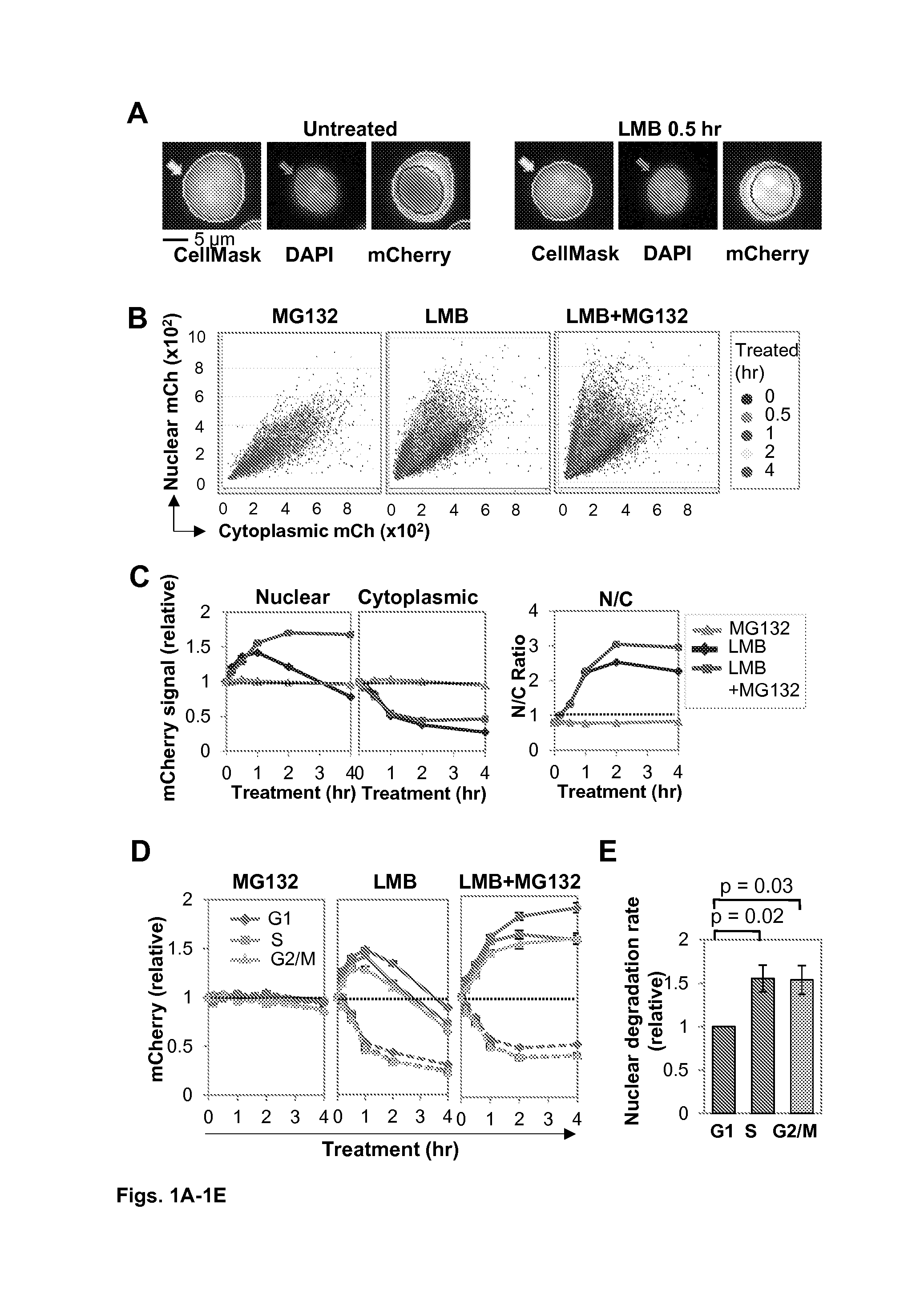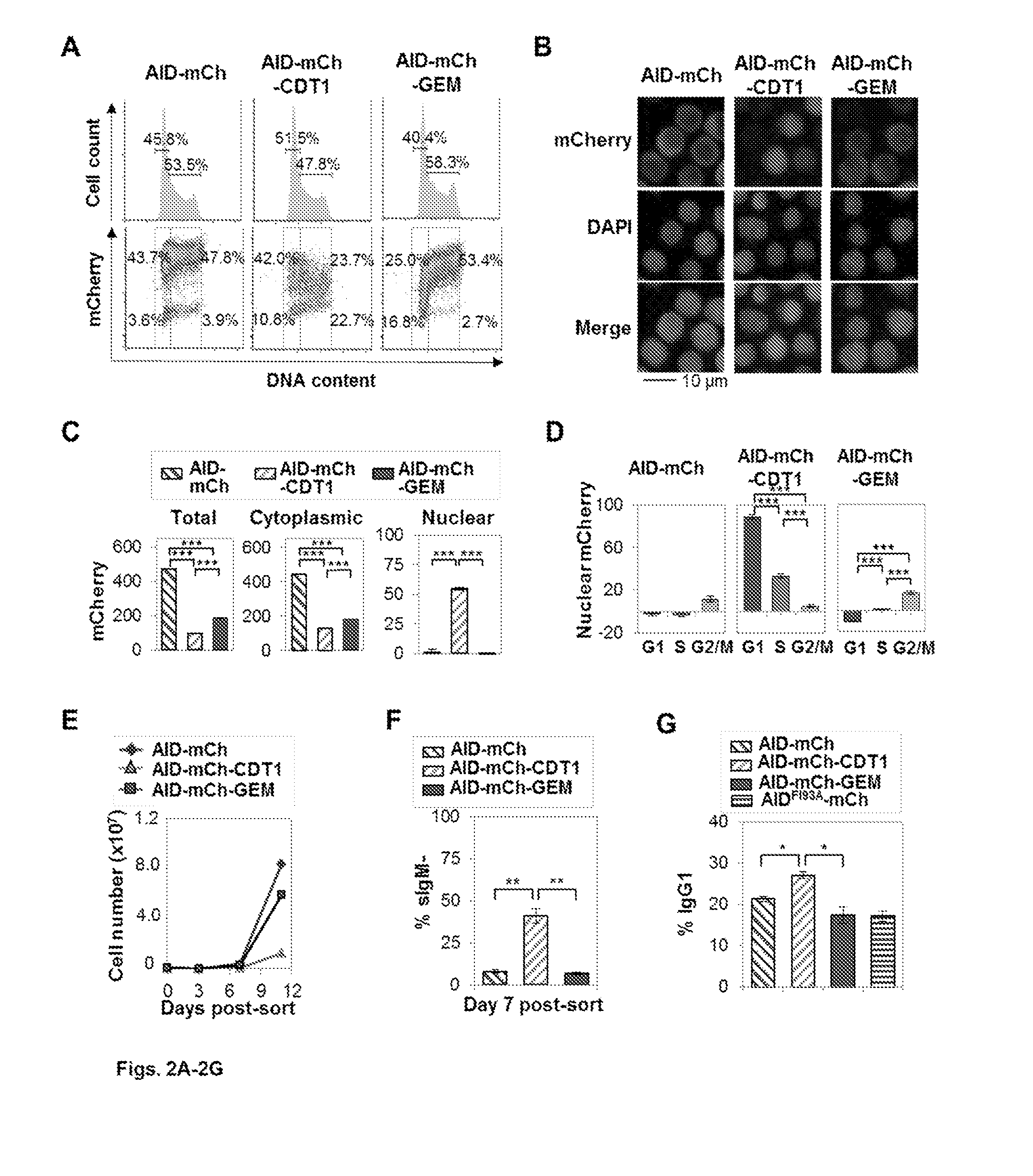Restricting nuclear protein to specific phases of the cell cycle
a cell cycle and nuclear protein technology, applied in the field of nuclear proteins and polypeptides to specific phases of the cell cycle, can solve the problems of reducing the efficiency of csr, compromising cell viability, and reducing the aid stability and efficiency of csr, so as to accelerate mutagenesis, enhance diversification, and enhance diversification
- Summary
- Abstract
- Description
- Claims
- Application Information
AI Technical Summary
Benefits of technology
Problems solved by technology
Method used
Image
Examples
example 1
Cell Cycle Regulates Nuclear Stability of AID and the Cellular Response to AID
[0086]This example illustrates features that support the invention, namely the means by which a diversification factor like AID can be modified to persist in the nucleus and also coupled with a nuclear destruction signal to protect cell viability. AID (Activation Induced Deaminase) deaminates cytosines in DNA to initiate immunoglobulin gene diversification and to reprogram the genome in early development. This example demonstrates how the cell cycle regulates AID and the cellular response to AID. Using high content screening microscopy to quantify subcellular localization, we show that AID undergoes nuclear degradation more slowly in G1 phase than in S or G2-M phase. Using CDT1 and GEM tags to promote degradation of nuclear AID in specific phases of cell cycle, we show that elevated nuclear AID accelerates somatic hypermutation and class switch recombination. Strikingly, nuclear AID is tolerated in G1 phas...
example 2
Modulation and Optimization of Chimeric Antigen Receptor T Cells
[0195]This example illustrates an embodiment of the invention that implements the principles described above for use with B cells to T cells. More specifically, one can use the invention described herein to modulate and optimize chimeric antigen receptor (CAR) T cells for use in therapeutic treatments. One can modulate and improve the affinity or specificity of a CAR T cell by transfecting a host T cell with a fusion construct of the invention. The fusion construct would couple a fragment of a protein targeted for nuclear destruction during a relevant portion of the cell cycle (e.g., CDT1 for destruction upon entry into S phase; GEM for G1 phase destruction) with AID modified to promote accumulation of AID in the nucleus. This construct stimulates diversification of the target gene to be optimized for immunotherapeutic use.
example 3
Modulation of Nuclear Protein Activity
[0196]This example illustrates an embodiment of the invention, whereby cell cycle tags derived from CDT1 or GEM (or other proteins involved in cell cycle control) can confer cell cycle restriction to enzymes that function in the nucleus. This modulation of nuclear protein activity can be of use, for example, in genome engineering. The nuclease activities of enzymes used to target DNA and the pathways of downstream repair can reflect the stage of cell cycle in which the DSB or nick occurs. For example, the frequency of a desired outcome (e.g. homology-directed repair) would be higher if DNA is cleaved in G1 phase, by an enzyme bearing a CDT1 tag; or the frequency of an undesired outcome (mutagenic end-joining) would be lower if DNA is cleaved in S phase, by an enzyme bearing a GEM tag.
[0197]Two enzymes widely used for genome engineering are CRISPR / Cas9, which creates targeted double-strand breaks (DSBs); and the CRISPR / Cas9D10A nickase, which cre...
PUM
| Property | Measurement | Unit |
|---|---|---|
| Fluorescence | aaaaa | aaaaa |
| Affinity | aaaaa | aaaaa |
Abstract
Description
Claims
Application Information
 Login to View More
Login to View More - R&D
- Intellectual Property
- Life Sciences
- Materials
- Tech Scout
- Unparalleled Data Quality
- Higher Quality Content
- 60% Fewer Hallucinations
Browse by: Latest US Patents, China's latest patents, Technical Efficacy Thesaurus, Application Domain, Technology Topic, Popular Technical Reports.
© 2025 PatSnap. All rights reserved.Legal|Privacy policy|Modern Slavery Act Transparency Statement|Sitemap|About US| Contact US: help@patsnap.com



